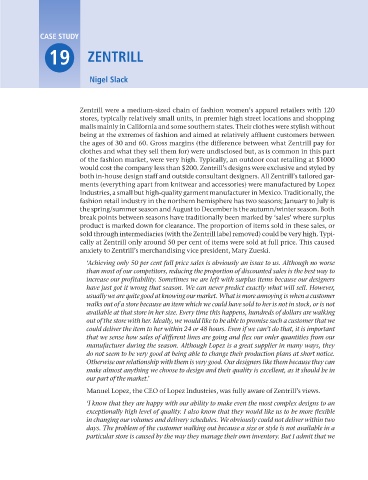Page 506 - Operations Strategy
P. 506
CaSE STudy
19 ZENTRILL
Nigel Slack
Zentrill were a medium-sized chain of fashion women’s apparel retailers with 120
stores, typically relatively small units, in premier high street locations and shopping
malls mainly in California and some southern states. Their clothes were stylish without
being at the extremes of fashion and aimed at relatively affluent customers between
the ages of 30 and 60. Gross margins (the difference between what Zentrill pay for
clothes and what they sell them for) were undisclosed but, as is common in this part
of the fashion market, were very high. Typically, an outdoor coat retailing at $1000
would cost the company less than $200. Zentrill’s designs were exclusive and styled by
both in-house design staff and outside consultant designers. All Zentrill’s tailored gar-
ments (everything apart from knitwear and accessories) were manufactured by Lopez
Industries, a small but high-quality garment manufacturer in Mexico. Traditionally, the
fashion retail industry in the northern hemisphere has two seasons; January to July is
the spring/summer season and August to December is the autumn/winter season. Both
break points between seasons have traditionally been marked by ‘sales’ where surplus
product is marked down for clearance. The proportion of items sold in these sales, or
sold through intermediaries (with the Zentrill label removed) could be very high. Typi-
cally at Zentrill only around 50 per cent of items were sold at full price. This caused
anxiety to Zentrill’s merchandising vice president, Mary Zueski.
‘Achieving only 50 per cent full price sales is obviously an issue to us. Although no worse
than most of our competitors, reducing the proportion of discounted sales is the best way to
increase our profitability. Sometimes we are left with surplus items because our designers
have just got it wrong that season. We can never predict exactly what will sell. However,
usually we are quite good at knowing our market. What is more annoying is when a customer
walks out of a store because an item which we could have sold to her is not in stock, or is not
available at that store in her size. Every time this happens, hundreds of dollars are walking
out of the store with her. Ideally, we would like to be able to promise such a customer that we
could deliver the item to her within 24 or 48 hours. Even if we can’t do that, it is important
that we sense how sales of different lines are going and flex our order quantities from our
manufacturer during the season. Although Lopez is a great supplier in many ways, they
do not seem to be very good at being able to change their production plans at short notice.
Otherwise our relationship with them is very good. Our designers like them because they can
make almost anything we choose to design and their quality is excellent, as it should be in
our part of the market.’
Manuel Lopez, the CEO of Lopez Industries, was fully aware of Zentrill’s views.
‘I know that they are happy with our ability to make even the most complex designs to an
exceptionally high level of quality. I also know that they would like us to be more flexible
in changing our volumes and delivery schedules. We obviously could not deliver within two
days. The problem of the customer walking out because a size or style is not available in a
particular store is caused by the way they manage their own inventory. But I admit that we
Z19 Operations Strategy 62492.indd 481 02/03/2017 14:02

